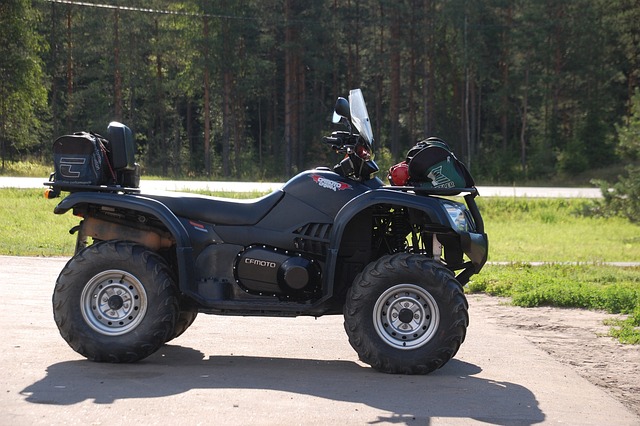During cold weather, ATV batteries can underperform due to the impact of low temperatures on their chemical reactions. To ensure your ATV starts reliably and remains operational in winter conditions, it's crucial to understand how temperature affects battery performance. The electrolyte solution thickens and loses conductivity as it cools, which can lead to reduced voltage and starting difficulties. To mitigate this, use a battery blanket or insulator to maintain warmth, clean terminals to prevent electrical loss, and regularly check and maintain electrolyte levels. For better cold resistance, consider upgrading to an AGM or lithium battery, which offer improved cold-cranking performance over traditional lead-acid batteries. Proper indoor storage away from drafts and direct sunlight is also essential. Regular maintenance includes keeping the battery fully charged with a low-temperature compatible charger, checking for corrosion, and ensuring secure connections. By following these precautions, you can maintain your ATV battery's health and ensure it remains dependable throughout the winter months.
When winter’s chill sets in, ensuring your ATV battery remains operational is crucial. This article delves into the unique challenges cold weather presents for ATV batteries and provides a comprehensive approach to maintaining their performance. From understanding how the cold affects battery life to a detailed guide on charging your ATV battery safely, we cover the essential steps and maintenance tips necessary to keep your ride ready for action, even in frigid conditions. Whether you’re an avid off-roader or preparing your vehicle for storage, this guide is tailored to help you navigate the cold with confidence.
- Understanding ATV Battery Performance in Cold Weather
- Preparing Your ATV Battery for Winter Conditions
- Step-by-Step Guide to Safely Charging an ATV Battery in Cold Temperatures
- Maintenance Tips and Best Practices for ATV Batteries in Cold Climates
Understanding ATV Battery Performance in Cold Weather

When temperatures plummet, ATV battery performance can be significantly affected. Cold weather can lead to sluggish battery output, as chemical reactions within the battery cells slow down due to lower temperatures. This is particularly true for lead-acid batteries, which are commonly used in all-terrain vehicles (ATVs). To ensure optimal performance during cold conditions, it’s crucial to understand how temperature impacts your ATV battery’s ability to hold a charge. The electrolyte solution inside the battery becomes thicker and less conductive as it cools, which can reduce the battery’s capacity to provide the necessary voltage. This can result in a harder start for your ATV or even leave you stranded if the battery is completely drained. Therefore, it’s advisable to keep your ATV battery warm, possibly by installing a battery blanket or insulator to maintain an optimal operating temperature range. Regular maintenance, such as cleaning terminals and checking electrolyte levels, can also help mitigate cold-weather performance issues. Additionally, choosing AGM (Absorbent Glass Mat) or lithium batteries over traditional lead-acid ones may offer better cold-cranking amps and overall reliability in low temperatures, making them a preferable choice for harsh winter conditions. Understanding these factors allows ATV enthusiasts to take proactive measures to ensure their vehicles remain operational, no matter how chilly it gets outside.
Preparing Your ATV Battery for Winter Conditions

When winter’s chill sets in, ensuring your ATV battery remains fully operational is crucial for maintaining your all-terrain vehicle’s readiness for use. The cold can significantly drain a battery’s power, leading to starting difficulties or even a dead battery when you need it most. To prepare your ATV battery for winter conditions, start by cleaning the terminals and cables, removing any corrosion or debris that could impede connectivity and efficiency. Use a battery cleaner and wire brush to thoroughly clean the posts and terminals, ensuring a good electrical connection. Next, inspect the battery case and casing for cracks or damage that could compromise its integrity and functionality in extreme temperatures.
Maintaining an optimal state of charge is key to preserving your ATV battery’s performance during winter. If possible, consider bringing your ATV indoors to a warm, dry place, where the temperature remains stable. Regularly charging your ATV battery with a quality battery charger designed for cold weather conditions can prevent sulfation and keep the battery in top shape. Opt for a charger that has a thermal sensor to safeguard against overcharging and damage from the low temperatures. Additionally, consider using a battery insulator or cover to protect the battery from the elements, ensuring it retains as much heat as possible while not obstructing the charging process. Properly maintaining and preparing your ATV battery for winter will ensure that it’s ready to perform when you’re eager to hit the trails again.
Step-by-Step Guide to Safely Charging an ATV Battery in Cold Temperatures

When temperatures drop, charging your ATV battery requires extra precautions. To ensure a safe and effective charge for your all-terrain vehicle’s battery in cold weather, follow this step-by-step guide. Begin by bringing the battery indoors to a warm, dry place. Ideally, the temperature should be above freezing. If the battery is already cold, gently warm it to room temperature before charging to prevent thermal shock and potential damage. Once at the correct temperature, connect your ATV battery charger, ensuring it’s designed for use in cold conditions. Follow the manufacturer’s instructions carefully; some chargers may have specific settings or modes for low-temperature operation. Throughout the charging process, monitor both the battery temperature and the charge level. If you notice any signs of excessive heat or frost buildup, stop the charging immediately and allow the battery to return to a safe temperature range before resuming. After the battery is fully charged, let it sit for at least 15 minutes to allow any residual cold to dissipate before installing it back in your ATV. This step helps prevent battery strain upon start-up, ensuring optimal performance and longevity even in the harshest winter conditions. Remember to always use a charger that’s compatible with your ATV battery type, whether it’s a lead-acid or lithium model, to avoid any complications during the charging process.
Maintenance Tips and Best Practices for ATV Batteries in Cold Climates

When operating an ATV in cold weather, maintaining your ATV battery’s health is paramount to ensure it performs optimally and has a longer lifespan. Firstly, select an appropriate battery for your ATV model that can handle low temperatures without losing efficiency. A high-quality ATV battery designed for cold climates will have a higher Cold Cranking Amps (CCA) rating, which indicates its ability to start in freezing conditions. Keeping the battery fully charged is also crucial; a fully charged battery at 75 degrees Fahrenheit can last up to one month, but this duration decreases as temperatures drop. Regularly charge your ATV battery with a reliable charger specifically designed for deep-cycle batteries, and avoid using the ATV frequently in very cold weather, as this can strain the battery and reduce its capacity.
Additionally, ensure that the battery is installed correctly and that all connections are clean, tight, and corrosion-free to prevent any electrical loss. Store your ATV indoors or in a sheltered area away from drafts and direct sunlight when not in use, as extreme temperatures can degrade the battery’s performance and shorten its life. If you must store the ATV outdoors, consider using a battery blanket or insulator to protect it from the cold. Regular maintenance checks should include inspecting the battery’s electrolyte levels and ensuring that the terminals are free of corrosion, as these can be affected by cold weather. By following these maintenance tips and best practices for ATV batteries in cold climates, you can maintain a reliable source of power for your vehicle throughout the winter months.
Ensuring your ATV battery remains functional during cold weather is pivotal for maintaining your all-terrain vehicle’s readiness. This article has delved into the intricacies of ATV battery performance in freezing conditions, offering comprehensive guidance on preparing and charging your battery safely when temperatures plummet. Following the outlined steps and adhering to maintenance tips will help extend your battery’s lifespan and reliability, allowing you to navigate winter terrains without a hitch. Remember to regularly check your ATV battery’s charge level, and consider investing in a quality battery charger designed for use in cold climates. By implementing these practices, you can safeguard your ATV’s power source and keep it primed for adventure, regardless of the season.



